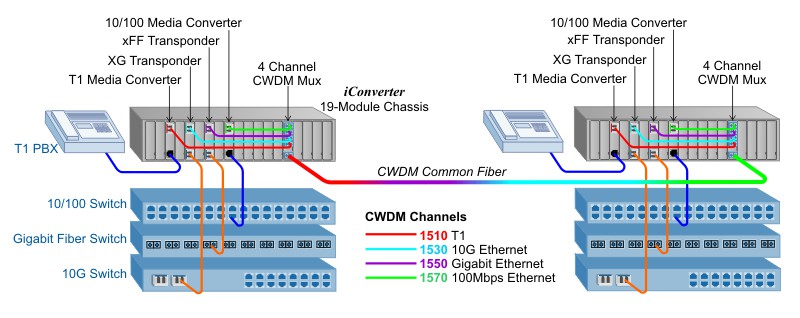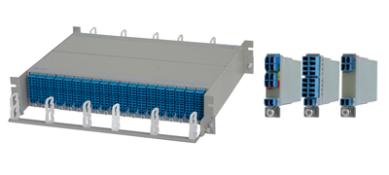Overview
Overview
Growing bandwidth requirements are stretching the capacity of fiber optic networks. Coarse Wavelength Division Multiplexing (CWDM) technology enables network managers to expand the capacity of fiber networks and deliver multiple data channels, or wavelengths, over a fiber optic cable.
CWDM has been a reliable and cost-effective solution for increasing capacity of fiber optic networks for over a decade. With CWDM, rather than transmitting one wavelength (or channel) at 1310nm or 1550nm, multiple wavelengths are transmitted over the fiber optic link, creating independent and simultaneous data streams that carry any protocol regardless of what is transmitted on the other wavelengths. CWDM supports up to 18 wavelengths, and each wavelength can transport up to 10G of data. Data from virtually any type of communications equipment can be carried over a CWDM network, including servers, switches and routers.
A challenge with CWDM multiplexing is connecting network equipment to a CWDM Multiplexer. CWDM requires specific wavelengths to be connected to the Channel ports so the wavelengths can be multiplexed over a Common Line fiber port. Fiber network equipment with fixed ST, SC or LC fiber ports with standard 850 or 1310 wavelengths, or copper network equipment with RJ-45 ports require a conversion to fiber with an appropriate CWMD wavelength. Fiber transponders and media converters that support SFP transceivers provide a simple and cost-effective solution to convert different ports on legacy network equipment to fiber with CWDM wavelengths.
CWDM Products
CWDM Products
iConverter® CWDM Multiplexers
iConverter CWDM Multiplexers are part of the iConverter Multi-Service Platform and used to expand the capacity of fiber networks. iConverter CWDM MUX/DEMUX modules and Optical Add Drop modules can be installed in a variety of compact and high-density chassis.
iConverter Transponders

iConverter Transponders are protocol-transparent fiber-to-fiber media converters, and are available as compact, unmanaged standalone units or managed chassis plug-in modules. iConverter Transponders provide reliable and cost-effective conversion between different wavelengths using CWDM SFP Transceivers and CWDM SFP+ and XFP Transceivers.
CWDM Multiplexer and Transponder Application
CWDM Multiplexer Application with Transponders and Media Converters
The following application example illustrates how the modular iConverter Multi-Service Platform enables a CWDM point-to-point network that incorporates four different network services originating from copper and fiber network equipment multiplexed over one common fiber line.
|
CWDM Wavelength |
Data Rate and Protocol |
Originating Equipment |
Wavelength Conversion |
|
1510nm |
1.544Mbps T1 |
T1 PBX |
T1 Media Converter |
|
1530nm |
10G Ethernet |
10G Switch |
XG 10G Transponder |
|
1550nm |
Gigabit Ethernet |
Gigabit SC Fiber Switch |
xFF Fiber Transponder |
|
1570nm |
100Mbps Ethernet |
10/100 Copper Switch |
10/100 Media Converter |
An iConverter 4-Channel CWDM/X Multiplexer, copper-to-fiber media converters and fiber-to-fiber transponders are installed in a high-density 19-module chassis. Data traffic from a T1 PBX, a 10G Ethernet switch, a Gigabit switch, and a 10/100 switch is connected to the CWDM multiplexer with the appropriate wavelengths using transponders and media converters.

A T1 PBX connects to the RJ-45 port on a T1 Copper-to-Fiber Media Converter with a CWDM SFP Transceiver that converts the T1 copper to a 1510nm CWDM wavelength that is connected to the 1510 Channel Port on the CWDM Multiplexer with a fiber patch cable (patch cables are shown in the illustration with the color of the wavelengths for clarity).
A 10G switch connects to an XG 10G Transponder that has a standard wavelength SFP+ Transceiver and a CWDM SFP+ Transceiver. The XG Transponder converts the standard wavelength to 1530nm CWDM wavelength that is connected to the 1530 Channel Port on the CWDM/X Multiplexer with a fiber patch cable. A CWDM SFP+ Transceiver could be installed in the fiber port of the 10G switch, but the XG Transponder is used as a less expensive alternative to the proprietary switch manufacturer’s SFP+ transceivers, and can save up to 50% per port.
A Gigabit switch with fixed SC 1310 fiber ports is connected to an xFF Transponder that has a standard wavelength SFP Transceiver and a CWDM SFP Transceiver. The xFF Transponder converts the standard wavelength to a 1550nm CWDM wavelength that is connected to the 1550 Channel Port on the CWDM/X Multiplexer with a fiber patch cable.
A 10/100 copper switch connects to the RJ-45 port on a 10/100 Copper-to-Fiber Media Converter with a CWDM SFP Transceiver that converts the copper Ethernet to a 1570nm CWDM wavelength that is connected to the 1570 Channel Port on the CWDM/X Multiplexer with a fiber patch cable.
The iConverter 4-channel CWDM Multiplexer multiplexes all four channels (wavelengths) over a common fiber link.
At the opposite end of the common CWDM link, a 4-Channel CWDM MUX de-multiplexes the four services (filters out each wavelength), and fiber links connect to each destination device with same configuration as the other end of the common fiber line.
This application illustrates that data from virtually any type of communications equipment can be carried over a CWDM network using the iConverter Multi-Service Platform. The modular iConverter Multi-Service Platform consists of managed media converters, fiber-to-fiber transponders (wavelength converters), T1/E1 multiplexers and CWDM multiplexers. These modules can be integrated in a variety of chassis configurations to create a flexible and scalable multi-service platform capable of delivering Ethernet, TDM and other services over existing fiber networks.
>> Learn more about CWDM Multiplexing at the CWDM Resource Center
>> Learn more about wavelength conversion using Transponders
NOTES:
- Up to 16 CWDM Channels can be converted from standard wavelengths and multiplexed over a common line with modules installed in a 19-Module chassis that uses just 2U of rack space (sixteen transponder or media converter modules, two 8 Channel Multiplexers, and one Band Splitter).
- CWDM/X Multiplexers that feature Pass Band ports enable the transport of a legacy 1310 or 1550 wavelength along with CWDM wavelengths
- CWDM/X Multiplexers that feature Expansion Ports enable connecting another CWDM Multiplexer with additional (and different) wavelengths
- Network equipment can be located in the same rack with CWDM Multiplexers, or in remote locations connected to a CWDM multiplexer in a hub location.
- CWDM transceivers can be installed directly in fiber equipment that supports SFP transceivers for direct connectivity to channel ports on a CWDM multiplexer.











